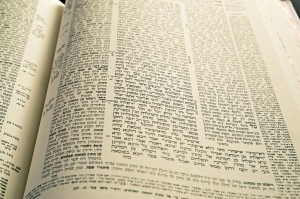Musings from Students of the Pardes Institute of Jewish Studies in Jerusalem
Posted on January 7, 2013 by Laurie Franklin
From my blog:
 It’s been a long, dry spell in this blog, its onset corresponding somewhat ironically with the start of Jerusalem’s rainy season. The rainy season began with a clap of thunder and a few minutes of soft rain. I heard the thunder and didn’t quite believe it. Ran out to the merpeset (balcony) and felt the rain on my face! Everywhere around me, on other balconies, at open windows, and in the street, people stopped, marveled, and smiled! Here’s the rain, a necessary arrival after Israel’s dry, hot summer.
It’s been a long, dry spell in this blog, its onset corresponding somewhat ironically with the start of Jerusalem’s rainy season. The rainy season began with a clap of thunder and a few minutes of soft rain. I heard the thunder and didn’t quite believe it. Ran out to the merpeset (balcony) and felt the rain on my face! Everywhere around me, on other balconies, at open windows, and in the street, people stopped, marveled, and smiled! Here’s the rain, a necessary arrival after Israel’s dry, hot summer.
The new rain closely followed the start of the fall semester at Pardes Institute, where I am studying. Since then, I have been immersed in a world of Jewish learning. My “short” days are 10 hours long; the rest are 12 to 14 hours. It’s true that I could opt to take fewer classes, but there’s so much to learn and few resources for it at home in Missoula, so I am overstuffing my days here in Jerusalem.
To give you a sense of Yeshiva learning, first, let me explain the atmosphere of the beit midrash, a room whose name can be translated as “house of teaching and learning”. You might think a beit midrash is a library because its walls are lined with books and its floor with library tables. But unlike a library, the beit midrash is LOUD, filled with people working in chevruta, typically in pairs, animatedly discussing the texts they are reading. The emphasis is interaction, not solitary study.

The chevruta relationship is the foundation of the Yeshiva study experience. I meet daily with my chevruta during class time to translate and understand the deeper meanings of the study texts. For each of my morning, text-based classes—Chumash (Bible) and Talmud—I have a different chevruta. I also have a chevruta for each of my two mid-afternoon classes, Rabbinic Thought and Social Justice. So, that’s four intense study relationships! At the beginning of the semester, our teachers introduced us to the dynamics of chevruta: what makes the study relationship work, how to go about it, and how to find a good match. Many of us had “chevruta anxiety”: Will I find someone with whom I can work well? We “dated” with potential study partners and “proposed” to the most likely ones. Then, we settled into the semester to learn.
As chevruta, we take turns reading and translating. Especially in the morning classes, Chumash and Talmud, we offer suggestions and actively correct each other’s grammar, pronunciation and translation. We try to progress from simple translation to thinking critically about the deeper meanings of the texts. As I work with each chevruta, I’ve noticed that our mutual trust builds, and we feel greater comfort in the role of challenging each other with respect. In fact, as we become accustomed to offering and receiving constructive criticism, the strength of the study friendship grows. We appreciate each other’s unique qualities and take pride in helping each other learn. I value my interaction with my four chevrutot because we learn better together than apart. So, here’s a shout-out to Emily Landau, Tadea Klein, Ben Gurin, and Kayla Higgins, my treasured learning partners in the Pardes beit midrash.